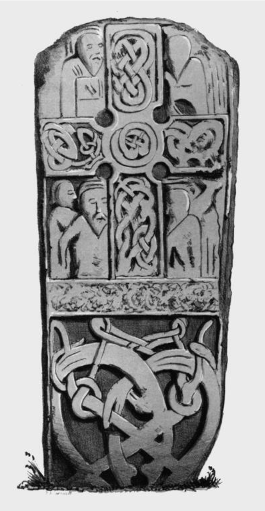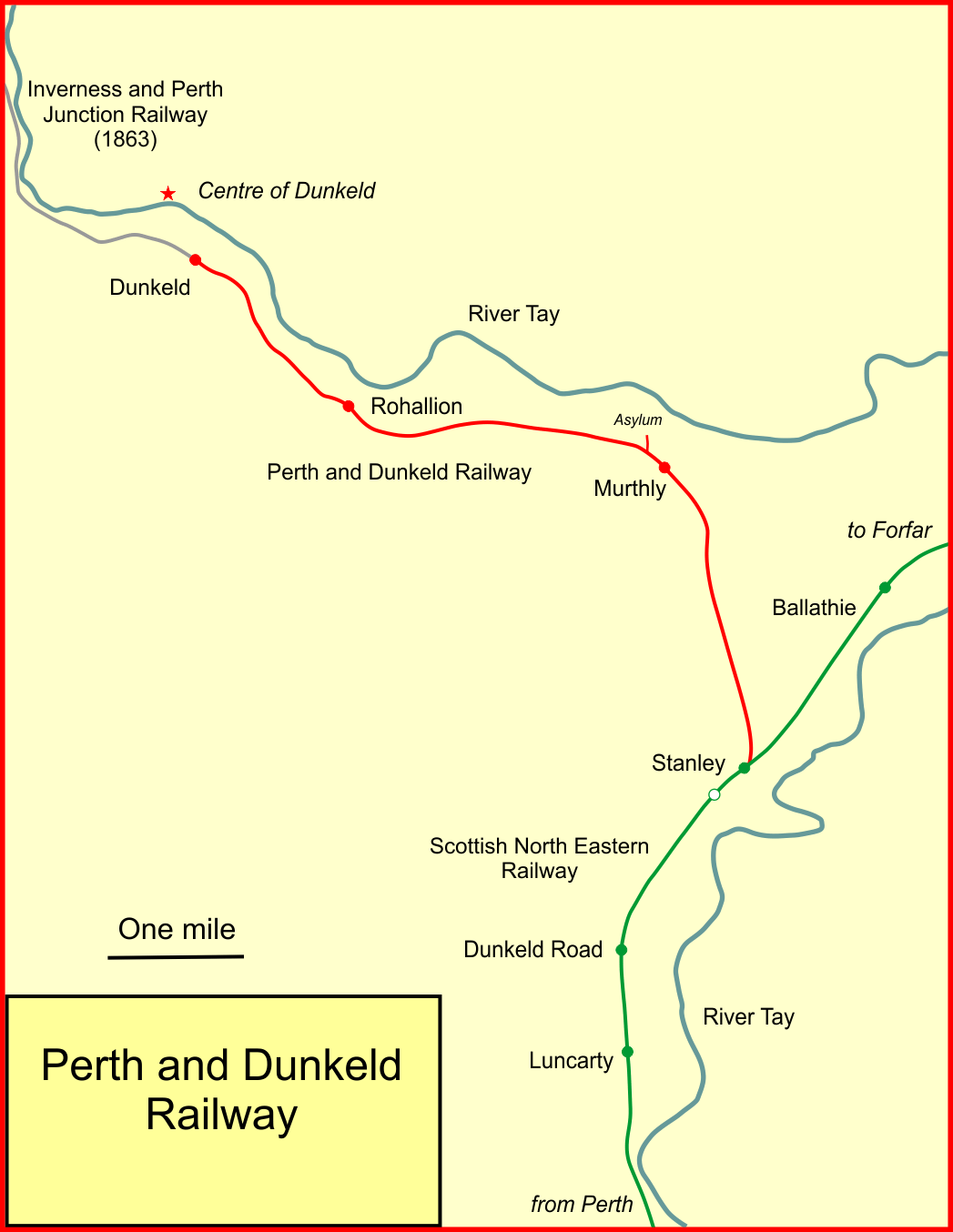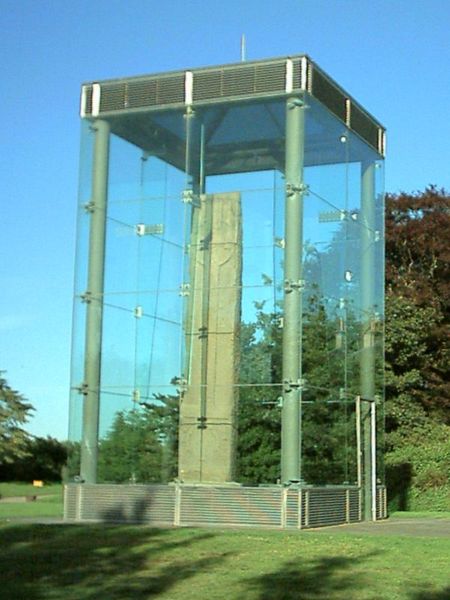|
Strathspey Railway (GNoSR)
The Strathspey Railway was a railway company in Scotland that ran from Dufftown (in Moray) to Boat of Garten (in Badenoch and Strathspey). It was proposed locally but supported by the larger Great North of Scotland Railway (GNoSR), which wanted to use it as an outlet towards Perth. The GNoSR had to provide much of the funding, and the value of traffic proved to be illusory. The line opened in 1863 to Abernethy, but for the time being was unable to make the desired connection to the southward main line. Although later some through goods traffic developed, the route never achieved its intended purpose. In common with many rural railways, it lost business heavily to competing road transport, both passenger and freight, from the 1930s. In 1958 lightweight diesel railbuses were used on the line in an attempt to contain the fast-rising financial losses, but the novel form of vehicle failed to bring about the necessary profitability. The line was closed to passenger traffic in 196 ... [...More Info...] [...Related Items...] OR: [Wikipedia] [Google] [Baidu] |
Scotland
Scotland (, ) is a country that is part of the United Kingdom. Covering the northern third of the island of Great Britain, mainland Scotland has a border with England to the southeast and is otherwise surrounded by the Atlantic Ocean to the north and west, the North Sea to the northeast and east, and the Irish Sea to the south. It also contains more than 790 islands, principally in the archipelagos of the Hebrides and the Northern Isles. Most of the population, including the capital Edinburgh, is concentrated in the Central Belt—the plain between the Scottish Highlands and the Southern Uplands—in the Scottish Lowlands. Scotland is divided into 32 administrative subdivisions or local authorities, known as council areas. Glasgow City is the largest council area in terms of population, with Highland being the largest in terms of area. Limited self-governing power, covering matters such as education, social services and roads and transportation, is devolved from the ... [...More Info...] [...Related Items...] OR: [Wikipedia] [Google] [Baidu] |
Elgin, Moray
Elgin (; sco, Ailgin; gd, Eilginn, ) is a town (former cathedral city) and formerly a Royal Burgh in Moray, Scotland. It is the administrative and commercial centre for Moray. The town originated to the south of the River Lossie on the higher ground above the floodplain where the town of Birnie is. There, the church of Birnie Kirk was built in 1140 and serves the community to this day. Elgin is first documented in the Cartulary of Moray in 1190 AD. It was created a royal burgh in the 12th century by King David I of Scotland, and by that time had a castle on top of the present-day Lady Hill to the west of the town. The origin of the name Elgin is likely to be Celtic. It may derive from 'Aille' literally signifying beauty, but in topography a beautiful place or valley. Another possibility is 'ealg', meaning both 'Ireland' and 'worthy'. The termination 'gin' or 'in' are Celtic endings signifying little or diminutive forms, hence Elgin could mean beautiful place, worthy place or l ... [...More Info...] [...Related Items...] OR: [Wikipedia] [Google] [Baidu] |
Craigellachie Station , a national nature reserve near Aviemore, Scotland
{{disambig, geo ...
Craigellachie may refer to: * Craigellachie, British Columbia, Canada * Craigellachie, Moray, Scotland ** Craigellachie railway station ** Craigellachie distillery * Craigellachie, Windsor, a heritage-listed house in Windsor, Brisbane, Queensland, Australia * Craigellachie National Nature Reserve Craigellachie (Scottish Gaelic: ) is a hill lying to the west of the village of Aviemore in Strathspey, in the central Highlands of Scotland. Craigellachie was declared a national nature reserve (NNR) in 1961, and is managed by NatureScot through ... [...More Info...] [...Related Items...] OR: [Wikipedia] [Google] [Baidu] |
Board Of Trade
The Board of Trade is a British government body concerned with commerce and industry, currently within the Department for International Trade. Its full title is The Lords of the Committee of the Privy Council appointed for the consideration of all matters relating to Trade and Foreign Plantations, but is commonly known as the Board of Trade, and formerly known as the Lords of Trade and Plantations or Lords of Trade, and it has been a committee of the Privy Council of the United Kingdom. The board has gone through several evolutions, beginning with extensive involvement in colonial matters in the 17th century, to powerful regulatory functions in the Victorian Era and early 20th century. It was virtually dormant in the last third of 20th century. In 2017, it was revitalised as an advisory board headed by the International Trade Secretary who has nominally held the title of President of the Board of Trade, and who at present is the only privy counsellor of the board, the other m ... [...More Info...] [...Related Items...] OR: [Wikipedia] [Google] [Baidu] |
William Yolland
William Yolland CB, FRS FRSA (17 March 1810 – 4 September 1885) was an English military surveyor, astronomer and engineer, and was Britain's Chief Inspector of Railways from 1877 until his death. He was a redoubtable campaigner for railway safety, often in the face of strong opposition, at a time when railway investment was being directed towards the expansion of the networks rather than the prevention of accidents. He was a member of the three-man committee of inquiry into the Tay Bridge disaster.Vetch (2004) Career Yolland was born in Plympton St Mary, Devon, the son of the land agent to Lord Morley, Plymouth, and his father promoted the boy's interest in surveying and land management by enrolling him at a school specialising in mathematics. He was commissioned into the Royal Engineers in 1828 and completed his technical training at the Royal School of Military Engineering in Chatham, Kent, in 1831. Ordnance Survey After army service in Britain, Ireland and Canada he ... [...More Info...] [...Related Items...] OR: [Wikipedia] [Google] [Baidu] |
Grantown-on-Spey
Grantown-on-Spey ( gd, Baile nan Granndach) is a town in the Highland Council Area, historically within the county of Moray. It is located on a low plateau at Freuchie beside the river Spey at the northern edge of the Cairngorm mountains, about south-east of Inverness ( by road). The town was founded in 1765 as a planned settlement and was originally called simply Grantown after Sir James Grant. The addition 'on Spey' was added by the burgh council in 1898. The town has several listed 18th and 19th century buildings, including several large hotels and serves as a regional centre for tourism and services in the Strathspey region. The town is twinned with Notre-Dame-de-Monts in the Vendée, Pays de la Loire, France. History The burgh was founded in 1765 during the early stages of the Industrial Revolution to encourage both agricultural marketing and handicrafts, as well as to increase local land values and to reduce unemployment and emigration. This was part of a wider ef ... [...More Info...] [...Related Items...] OR: [Wikipedia] [Google] [Baidu] |
Scottish North Eastern Railway
The Scottish North Eastern Railway was a railway company in Scotland operating a main line from Perth to Aberdeen, with branches to Kirriemuir, Brechin and Montrose. It was created when the Aberdeen Railway amalgamated with the Scottish Midland Junction Railway on 29 July 1856. It did not remain independent for long, for it was itself absorbed by the Caledonian Railway on 10 August 1866. Much of its network closed in 1967 when the former North British Railway route to Aberdeen via Dundee became the main route. Constituents Early authorisations There was a frenzy of railway promotions in Scotland in 1845; there had been widespread controversy over a route from central Scotland to England, where a railway network was forming, and the public discussion encouraged thought of Scottish routes too. On 31 July 1845 the Caledonian Railway was authorised, with the then enormous capital of £1,500,000, to build from Glasgow and Edinburgh to Carlisle. On the same day the Scottish Centra ... [...More Info...] [...Related Items...] OR: [Wikipedia] [Google] [Baidu] |
Perth And Dunkeld Railway
The Perth and Dunkeld Railway was a Scottish railway company. It was built from a junction with the Scottish Midland Junction Railway at Stanley, north of Perth, to a terminus at Birnam, on the south bank of the River Tay opposite Dunkeld. It was promoted by local landed proprietors, and opened in 1856. As a minor branch line inconveniently serving a modest town, its financial performance was poor. However, when a railway line from Inverness to Perth was promoted, the Dunkeld line was taken as part of the new route, which opened in 1863; the Perth and Dunkeld Railway Company ceased to exist, and the line was now part of the Inverness and Perth Junction Railway. The original line of the P&DR continues in use today, an intrinsic part of the Highland Main Line. Independence at first Aberdeen was connected to the railway network of Central Scotland in 1850. Inverness too expected a southward connection, but the intervening terrain was unpromising, and two railway schemes proposed a ... [...More Info...] [...Related Items...] OR: [Wikipedia] [Google] [Baidu] |
Inverness And Perth Junction Railway
The Inverness and Perth Junction Railway (I&PJR) was a railway company that built a line providing a more direct route between Inverness and the south for passengers and goods. Up to the time of its opening, the only route was a circuitous way through Aberdeen. The I&PJR was built from a junction with the friendly Inverness and Aberdeen Junction Railway at Forres to the Perth and Dunkeld Railway at Dunkeld. It opened for traffic in 1863. The northern part of its route crossed wild and sparsely populated terrain, and the high summits on the line were challenging for the locomotives of the day. In 1865 the Company merged with the Inverness and Aberdeen Junction Railway, together forming the Highland Railway. A short branch to Aberfeldy was built by the company 1865, and this closed in 1965. Towards the end of the century the Highland Railway came under political pressure from competing railway proposals, and agreed to build a shorter route between Inverness and Aviemore, connect ... [...More Info...] [...Related Items...] OR: [Wikipedia] [Google] [Baidu] |
Forres
Forres (; gd, Farrais) is a town and former royal burgh in the north of Scotland on the Moray coast, approximately northeast of Inverness and west of Elgin. Forres has been a winner of the Scotland in Bloom award on several occasions. There are many geographical and historical attractions nearby such as the River Findhorn, and there are also classical, historical artifacts and monuments within the town itself, such as Forres Tolbooth and Nelson's Tower. Brodie Castle, the home of the Brodie Clan, lies to the west of the town, close to the A96. A list of suburbs in the town of Forres contains: Brodie, Dalvey, Mundole and Springdale. Pre-history and archaeology Between 2002 and 2013 some 70 hectares of land was investigated by archaeologists in advance of a proposed residential development on the southern fringes of the town. They found an extensive Iron Age settlement and evidence that people lived in the area from the Neolithic (radiocarbon dates from the 4th to the mi ... [...More Info...] [...Related Items...] OR: [Wikipedia] [Google] [Baidu] |
River Spey
The River Spey (Scottish Gaelic: Uisge Spè) is a river in the northeast of Scotland. At it is the eighth longest river in the United Kingdom, as well as the second longest and fastest-flowing river in Scotland. It is important for salmon fishing and whisky production. Etymology The origin of the name ''Spey'' is uncertain. A possible etymological genesis for the name ''Spey'' is Early Celtic ''*skwej-'', meaning "thorn". The involvement of a Pictish form of Welsh ''ysbyddad'', meaning "hawthorn", has been suggested, but adjudged unlikely. One proposal is a derivation from a Pictish cognate of Old Gaelic ''sceïd'', "vomit" (c.f Welsh ''chwydu''), which is dubious both on phonological and semantic grounds. Ptolemy named the river on his map of 150 as ''Tuesis''. The name 'Spey' first appears in 1451. Course The Spey is long. It rises at over at Loch Spey in Corrieyairack Forest in the Scottish Highlands, south of Fort Augustus. Some miles downstream from its sour ... [...More Info...] [...Related Items...] OR: [Wikipedia] [Google] [Baidu] |
Dandaleith Railway Station
Dandaleith railway station served the village of Craigellachie, Moray, Scotland from 1858 to 1965 on the Morayshire Railway. History The station opened as Craigellachie on 23 December 1858 by the Great North of Scotland Railway The Great North of Scotland Railway (GNSR) was one of the two smallest of the five major Scottish railway companies prior to the 1923 Grouping, operating in the north-east of the country. Formed in 1845, it carried its first passengers the fr .... It was the southern terminus of the line until opened in 1863. To the north was a goods yard. The station's name was changed to Dandaleith in 1864 to avoid confusion with the Craigellachie station that opened to the south a year before. It was downgraded to an unstaffed halt in 1931, although it became staffed after 7 June 1953. Eventually, only one train a day called at the station and it closed to both passengers on 5 March 1962 and closed to goods traffic on 18 November 1965. References Di ... [...More Info...] [...Related Items...] OR: [Wikipedia] [Google] [Baidu] |









